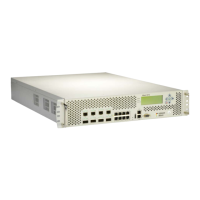Alteon Application Switch Operating System Application Guide
Load Balancing Special Services
302 Document ID: RDWR-ALOS-V2900_AG1302
request from a client, the RADIUS server instructs Alteon to create a static session entry via the
Transparent Proxy Control Protocol (TPCP). TPCP is a proprietary protocol that is used to establish
communication between the RADIUS servers and Alteon. It is UDP-based and uses ports 3121,
1812, and 1645.
The RADIUS servers use TPCP to add or delete static session entries on Alteon. Typically, a regular
session entry is added or removed by Alteon itself. A static session entry, like a regular session
entry, contains information such as the client IP address, the client port number, real port number,
virtual (destination) IP address, and virtual (destination) port number.
A static session entry added via TPCP to Alteon does not age out. The entry is only deleted by
another TPCP Delete Session request. If the user adds session entries using the traditional server
load balancing methods, the entries will continue to age out.
Because TPCP is UDP-based, the Add/Delete Session requests may get lost during transmission. The
WAP gateway issues another Add Session request on detecting that it has lost a request. The WAP
gateway detects this situation when it receives WAP traffic that does not belong to that WAP
gateway. If a Delete Session request is lost, it is overwritten by another Add Session request.
How WAP SLB Works with Static Session Entries
1. On dialing, the user is first authenticated by the Remote Access Server (RAS).
2. The RAS sends a RADIUS authentication request to one of the RADIUS servers, which can be
integrated with a WAP gateway.
3. If the user is accepted, the RADIUS server determines which WAP gateway is right for this user
and informs Alteon of the decision via TPCP.
4. Alteon receives a request from the RADIUS server, and adds a session entry to its session table
to bind a WAP gateway with that user.
5. A response packet is sent back to the RAS by the RADIUS server.
6. The RAS receives the packet and allows the WAP traffic for that user.
7. If the user disconnects, the RAS detects it and sends this information to the RADIUS server.
8. The RADIUS server removes the session entry for that user.
Configuring WAP SLB using Static Session Entries
This procedure references Figure 46 - Load Balancing WAP Gateways, page 301.
To configure WAP SLB using static session entries
1. Before you start configuring WAP load balancing:
— Enable Layer 3 server load balancing.
— Enable UDP under the WAP services (ports 9200 to 9203) menu.
>> # /cfg/slb/virt <number> /layr3 ena
>> # /cfg/slb/virt <number> /service <name|number> /protocol udp

